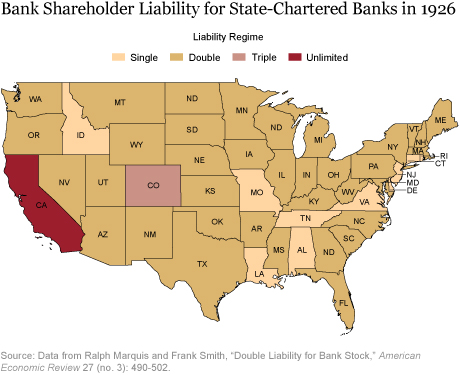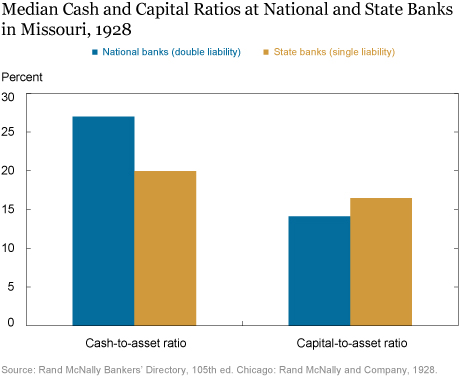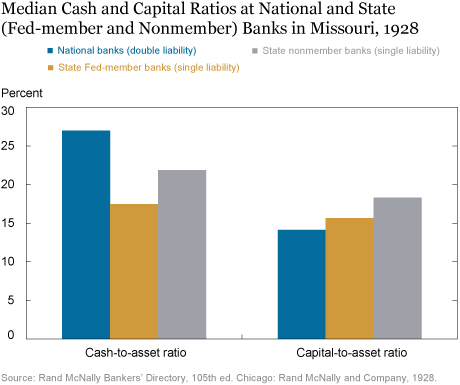It is widely said that a lack of “skin in the game” would distort lenders’ incentives and cause a moral hazard problem, that is, excessive risk‑taking. If so, does more skin in the game—in the form of extended liability—reduce bankers’ risk‑taking? In order to examine this question, we investigate historical data prior to the Great Depression, when bank owners’ liability for losses in the event of bank failure differed by state and primary regulator. This post describes our preliminary findings.
Excessive risk-taking by banks has long been a paramount concern of regulators. The basic problem arises in part due to misaligned incentives; under the current limited (single) liability structure, shareholders of a failed bank can lose no more than their initial investment. With this limited skin in the game, bank shareholders’ private incentives may lead them to take more risk than is socially optimal. If, by contrast, shareholders were liable for the entirety of a bank’s losses, their private risk-taking decisions may be more aligned with socially optimal risk‑taking.
Extended Liability before the Great Depression
Bank liability was not always so limited. Before the Great Depression, bank shareholders in some states were responsible (in proportion to their shareholdings) for their initial investment plus some or all of the unpaid debts of a failed bank with negative net worth. The map below shows how bank shareholder liability structure varied by state in 1926. Under double liability, the most common regime, bank shareholders were liable for as much as the par value of their shares plus their initial investment to cover losses by a failed bank.

Extended Liability and Bank Risk-Taking in Theory
While the additional skin in the game under double liability should, in theory, mitigate excessive risk-taking, there could also be offsetting effects as well. For example, it could be the case that these banks were better able to attract less sophisticated depositors lulled by a sense of safety due to extended liability. If such depositors were less likely to withdraw deposits when the banks’ financial conditions deteriorated, the weakened “depositor discipline” could incentivize bankers to take more risks. An alternative offsetting effect could arise from “adverse selection” since the investors who select to own shares in a double liability bank are likely the most risk tolerant. If either effect was operating, double liability banks might take similar or even more risk than limited liability banks. Because the effect of limiting liability on bank risk-taking is difficult to untangle theoretically, we turn to historical data for some evidence.
Preliminary Evidence: The Missouri Case
Identifying the effect of extended liability on bank risk is not simple. Since economic conditions varied substantially across states in the early twentieth century, we can’t compare banks in, say, California, which adopted unlimited liability, to those in New Jersey, which adopted limited liability. One way to get variation in liability structure within the same state is to exploit the dual banking system, under which national banks are regulated by federal agencies but state banks are regulated by state agencies. In the late 1920s, all national banks were governed by double liability, whereas state bank liability varied by state. Thus, by comparing national (double liability) banks to banks in a state with limited liability, such as Missouri, we can better isolate the effect of liability on risk‑taking while holding economic conditions more or less constant.
In the chart below, we compare cash and capital ratios (relative to assets) at national and state banks in Missouri in 1928. Both ratios are fundamental risk measures: cash (liquidity) buffers against depositors’ withdrawals and runs (a real risk then as deposits were not yet federally insured) and capital acts as a buffer against losses.

Under the standard skin-in-the-game theory, we would expect both ratios to be higher at the double liability/national banks. In fact, they did hold higher cash cushions, thus reducing their liquidity/run risk, but their capital buffers were lower, leaving them less protected against default risk or other losses. This finding seems to contradict the standard expectation.
The higher capital ratio at limited liability/state banks may reflect another institutional difference: state banks that were not members of the Federal Reserve System sometimes faced different capital requirements (per state law) while state banks that were members were subject to the same capital requirements as national banks. In Missouri, state nonmembers faced higher capital requirements than state member and national banks so the capital difference above may have been an artifact of that regulatory difference.
In the next chart, we break out cash and capital ratios for those three sets of banks in Missouri. This comparison reveals an even bigger difference in cash cushions between national and state member banks, and a smaller (though still negative) difference in capital buffers.

The larger difference in capital buffers in the first comparison above (national vs. state) was driven in part by a higher capital requirement for state nonmember banks. Overall, however, it’s not clear whether the extra skin in the game for double liability banks made them safer—they were more liquid than state member banks but also slightly more levered. We emphasize, however, that this interpretation is tentative; we are currently collecting data for a more detailed, rigorous analysis across multiple states.
Disclaimer
The views expressed in this post are those of the authors and do not necessarily reflect the position of the Federal Reserve Bank of New York or the Federal Reserve System. Any errors or omissions are the responsibility of the authors.
Haelim Anderson is a research economist at the Office of Financial Research at the U.S. Department of Treasury.
Daniel Barth is a research economist at the Office of Financial Research at the U.S. Department of Treasury.

Dong Beom Choi is a financial economist in the Federal Reserve Bank of New York’s Research and Statistics Group.
How to cite this blog post:
Haelim Anderson, Daniel Barth, and Dong Beom Choi, “Does More ‘Skin in the Game’ Mitigate Bank Risk-Taking?,” Federal Reserve Bank of New York Liberty Street Economics (blog), February 12, 2018, http://libertystreeteconomics.newyorkfed.org/2018/02/does-more-skin-in-the-game-mitigate-bank-risk-taking.html.











 RSS Feed
RSS Feed Follow Liberty Street Economics
Follow Liberty Street Economics
Interesting analysis, but I thought that BOTH the higher cash ratio and lower capital for double indemnity banks was a logical outcome. The lower capital ratio – if I understand the graphic properly – reflects only the cash portion of equity, not the backup ‘unfunded commitment’ portion. A double indemnity bank should be able to compete successfully for depositors by advertising its hard ‘total ownership support ratio’, including both the funded and the unfunded portions of capital. Creditors might haircut the value of the unfunded portion – perhaps by 50% or so. but the net solvency support would still be stronger in this case from the double indemnity group.
Well done. To me the bigger issue is that banks are, to a large extent, financing a major worldwide bubble. If/when the bubble bursts, many banks will not have the capital to withstand the downturn, skin in, or not. The FED/Treasury need to prepare for this.
When the owner/manager is on the hook, what you discover is that it’s liquidity, and certainty of liquidity, that really matters. Absent total economic meltdown (which usually follows, not precedes, a banking crisis), it’s not that easy for a bank to lose all its capital unless it has to fire sale assets. Owner/managers will tend to overshoot the LCR and undershoot the leverage ratio.